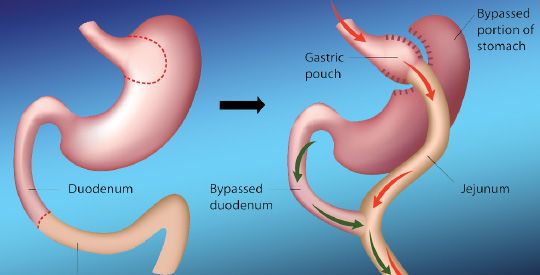Laparoscopic Roux-en-Y Gastric Bypass Surgery
In recent years, bariatric surgery has emerged as a viable solution for individuals struggling with obesity and related health issues. Among the various procedures, Laparoscopic Roux-en-Y Gastric Bypass (LRYGB) stands out as a highly effective and commonly performed surgery.
I. Overview of Laparoscopic Roux-en-Y Gastric Bypass
Laparoscopic Roux-en-Y Gastric Bypass is a minimally invasive surgical procedure designed to help individuals achieve significant weight loss by altering the anatomy of the stomach and small intestine. It is particularly suitable for those with severe obesity or obesity-related health conditions.
The surgery involves creating a small stomach pouch and rerouting a section of the small intestine, resulting in reduced food intake and decreased absorption of calories. The laparoscopic approach, using small incisions and a camera for visualization, has become the preferred method due to its advantages in terms of reduced scarring and quicker recovery.
II. Surgical Procedure
A. Initial Steps:
Anesthesia: The patient is placed under general anesthesia to ensure comfort and safety during the procedure.
Incisions: Small incisions are made in the abdominal wall to insert a laparoscope and surgical instruments.
B. Creation of the Stomach Pouch:
Stapling: The surgeon uses surgical staples to create a small pouch at the top of the stomach. This pouch limits the amount of food the patient can consume.
Separation: The newly formed pouch is separated from the rest of the stomach, reducing its capacity.
C. Rerouting the Small Intestine:
Jejunojejunostomy: The surgeon divides the small intestine and attaches the lower part to the newly created stomach pouch.
Bypassing the Duodenum: The upper part of the divided small intestine is connected further down the intestine, bypassing the duodenum and a portion of the jejunum.
III. Indications and Eligibility Criteria
Laparoscopic Roux-en-Y Gastric Bypass is recommended for individuals with a body mass index (BMI) of 40 or higher, or a BMI of 35 or higher with obesity-related health issues such as diabetes, hypertension, or sleep apnea. Candidates should have tried and failed to achieve significant weight loss through non-surgical methods.
IV. Benefits and Risks
A. Benefits:
Substantial Weight Loss: LRYGB typically results in significant and sustained weight loss, leading to improved overall health.
Resolution of Obesity-Related Health Issues: Many patients experience resolution or improvement in conditions such as type 2 diabetes, high blood pressure, and sleep apnea.
Enhanced Quality of Life: Weight loss often leads to increased mobility, improved self-esteem, and a better quality of life.
B. Risks:
Surgical Risks: As with any surgery, there are potential risks such as infection, bleeding, and adverse reactions to anesthesia.
Nutritional Deficiencies: The rerouting of the digestive tract may lead to deficiencies in certain vitamins and minerals, requiring lifelong supplementation.
Dumping Syndrome: Rapid passage of food from the stomach to the small intestine can cause nausea, vomiting, and diarrhea, known as dumping syndrome.
V. Postoperative Care and Lifestyle Changes
A. Hospital Stay:
Monitoring: Patients are closely monitored in the hospital for any signs of complications.
Pain Management: Pain medications are administered to alleviate discomfort from the incisions.
B. Dietary Guidelines:
Gradual Progression: The diet is gradually advanced from liquids to pureed and soft foods, eventually transitioning to a regular diet.
Portion Control: Patients are advised to adopt lifelong habits of portion control to prevent overeating.
C. Physical Activity:
Gradual Increase: Physical activity is gradually introduced to promote weight loss and improve overall fitness.
Regular Exercise: Establishing a consistent exercise routine is crucial for long-term success.
VI. Comparison with Other Bariatric Procedures
Laparoscopic Roux-en-Y Gastric Bypass is one of several bariatric procedures available. A brief comparison with other common surgeries such as sleeve gastrectomy and adjustable gastric banding can help individuals make informed decisions based on their specific needs and health conditions.
VII. Success Stories
Personal accounts of individuals who have undergone Laparoscopic Roux-en-Y Gastric Bypass can serve as valuable insights for those considering the procedure. Real-life experiences often highlight the challenges, triumphs, and the transformative impact on both physical and mental well-being.
VIII. Long-Term Outcomes and Follow-up Care
Monitoring and follow-up care are essential components of the long-term success of Laparoscopic Roux-en-Y Gastric Bypass. Regular check-ups, nutritional assessments, and ongoing support from healthcare professionals contribute to sustained weight loss and optimal health outcomes.
IX. Evolving Trends and Innovations
As medical science advances, new technologies and approaches may emerge in the field of bariatric surgery. Keeping abreast of the latest trends and innovations can help individuals make informed decisions about their weight loss journey.
Conclusion
Laparoscopic Roux-en-Y Gastric Bypass Surgery has proven to be a transformative solution for individuals struggling with obesity and its associated health issues. While the procedure comes with its share of benefits and risks, the comprehensive approach, including postoperative care and lifestyle changes, plays a crucial role in ensuring long-term success. As the field of bariatric surgery continues to evolve, Laparoscopic Roux-en-Y Gastric Bypass remains a cornerstone in the battle against obesity, offering hope and a path to improved health and well-being.



